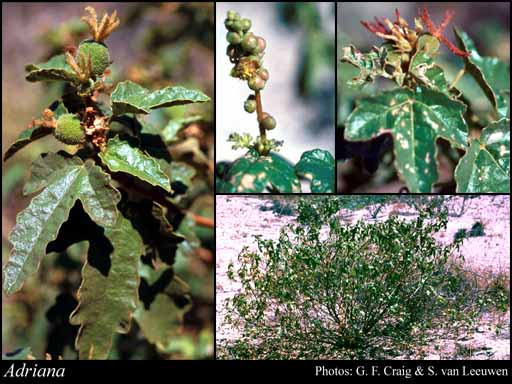- Reference
- Ann.Sci.Nat. (Paris) 223 (1825)
- Name Status
- Current

Scientific Description
Family Euphorbiaceae.
Habit and leaf form. Shrubs; laticiferous, or non-laticiferous and without coloured juice, or with coloured juice. Plants succulent, or non-succulent. Mesophytic, or xerophytic. Leaves minute to large; alternate, or opposite, or alternate and opposite; spiral, or distichous; leathery; petiolate to sessile; non-sheathing; gland-dotted, or not gland-dotted; simple. Leaf blades dissected (2–5-lobed), or entire; pinnately veined, or palmately veined. Leaves with stipules. Stipules represented by glands; caducous, or persistent. Leaf blade margins entire, or crenate, or serrate. Leaves without a persistent basal meristem. Leaf anatomy. Hairs present, or absent; complex hairs present, or absent. Complex hairs stellate. Urticating hairs present, or absent. Stem anatomy. Nodes tri-lacunar, or unilacunar. Secondary thickening developing from a conventional cambial ring, or anomalous; from a single cambial ring.
Reproductive type, pollination. Fertile flowers functionally male, or functionally female. Unisexual flowers present. Plants dioecious. Entomophilous.
Inflorescence and flower features. Flowers aggregated in ‘inflorescences’. Inflorescences terminal, or leaf-opposed (apparently); in male plants the main flower-bearing axis is an elongated conflorescence, often interrupted with clusters of 3–12 buds or flowers; the female conflorescence has fewer flowers and is usually shorter, with a terminal flower and clusters of 1–8 buds or flowers. Flowers bracteate; minute to small; regular. Floral receptacle developing an androphore (stamens crowded on a raised receptacle). Free hypanthium absent. Hypogynous disk present, or absent. Perianth sepaline; 4(–5) (in male flowers), or 3–6(–8) (in female flowers); 1 -whorled, or 2 -whorled (in female flowers, whorls indistinct). Calyx 3–8; 1 -whorled, or 2 -whorled; polysepalous, or gamosepalous; valvate (in male flowers); regular; persistent. Fertile stamens present, or absent (female flowers). Androecium 30. Androecial members free of the perianth; free of one another. Androecium exclusively of fertile stamens. Stamens 30 (or more); polystemonous; erect in bud, or inflexed in bud. Filaments very short. Anthers basally dorsifixed to the filaments; dehiscing via longitudinal slits; extrorse, or introrse; bisporangiate, or tetrasporangiate; appendaged. The anther appendages apical. Fertile gynoecium present, or absent (male flowers). Gynoecium 3 carpelled. The pistil 3 celled. Gynoecium syncarpous; synovarious, or synstylovarious (depending on interpretation of partially connate styles); superior. Ovary plurilocular; 3 locular. Styles (2–)3(–4); free, or partially joined (at the base); forked; apical. Stigmas 4–8; dry type; papillate; Group II type. Placentation axile, or apical. Ovules 1 per locule; pendulous; epitropous; with ventral raphe, or with dorsal raphe; arillate; orthotropous, or anatropous, or hemianatropous.
Fruit and seed features. Fruit non-fleshy; a schizocarp (capsular). Mericarps 3; rupturing ventrally. Fruit often explosively dehiscent. Seeds 1 per mericarp. Seeds endospermic. Endosperm oily. Seeds arillate. Cotyledons 2 (usually wider than the radicle). Embryo straight, or curved. Seedling. Germination phanerocotylar, or cryptocotylar.
Physiology, biochemistry. Mustard-oils present, or absent.
Geography, cytology, number of species. Native of Australia. Endemic to Australia. Australian states and territories: Western Australia, South Australia, Northern Territory, Queensland, New South Wales, Victoria, and Australian Capital Territory.